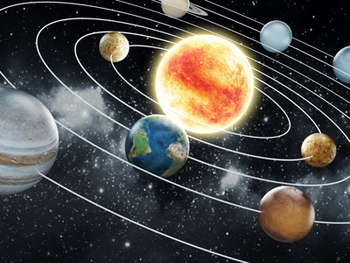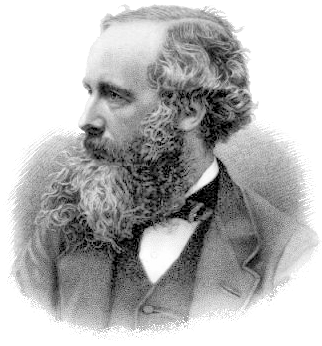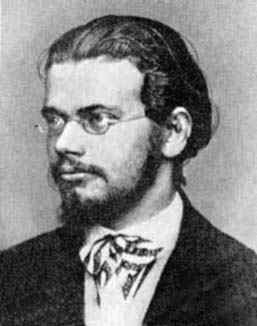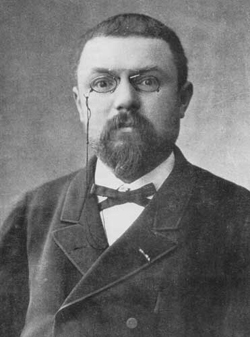
Kinetic theory: Taming multitudes
On November 30 1889 Henri Poincaré, one of history's greatest mathematicians, found himself in an embarrassing situation. He had won a prestigious prize offered by King Oscar II of Sweden, and he'd just discovered a mistake in the piece of work he had won it for. Poincaré's manuscript was already being printed for presentation to the king and the world. To his credit, he sent word to immediately stop the presses.

Predicting the motion of more than three bodies is hard.
The prize King Oscar had offered concerned the motion of celestial bodies. Around 200 years earlier Isaac Newton had formulated his laws of motion and gravitation, which tell you how bodies such as planets and stars behave when they feel the gravitational pull of another body. Newton himself had applied his laws to predict what would happen in a solar system consisting of only two bodies. He justified what Johannes Kepler had claimed before him: that the less massive body (eg the Earth) will orbit the more massive one (eg the Sun) on a trajectory that is shaped like an ellipse.
King Oscar's prize challenged mathematicians to come up with a description of the motion of, not just two, but any number of bodies exerting a gravitational pull on each (see here for a precise description of the prize question). This being too hard, Poincaré had focussed on systems with exactly three bodies. The error he had found took about a month to fix, and even then Poincaré's work didn't provide a simple answer to the problem. As soon as more than two celestial bodies are involved, the task of describing their trajectories becomes very, very hard.
From planets to plasmas
Fast forward to the present day and the motion of other celestial bodies is the least of our worries. With our own planet in the grip of a climate crisis, what we really need are clean and safe ways to generate energy. Nuclear fusion, though still out of immediate reach, would provide one. Instead of splitting the atom to release energy, which is what happens in nuclear fission, nuclear fusion involves fusing them together, mimicking what happens in the core of the Sun.
A nuclear fusion reactor would heat a gas to incredibly high temperatures and subject it to a strong electromagnetic field to produce a plasma full of interacting charged particles. Understanding the behaviour of these particles is important. And this lands us right back in the situation that faced Poincaré: systems of many components, whether they interact through gravity or the electrostatic force, are extremely hard to understand. And if Poincaré struggled with three, then how are we to cope with the billions of particles that make up a plasma?
Biology, people, and Big Data
This problem is currently being tackled by a research programme at the Isaac Newton Institute for Mathematical Sciences in Cambridge. The idea is not to solve Poincaré's three-body problem or to build a nuclear fusion reactor (this is still some way out of reach but actively pursued by experiments such as the ITER in France). Instead, the aim is to develop the mathematics of kinetic theory, which would ultimately apply to any system consisting of a large number of moving components.

Predator bluefin trevally sizing up schooling anchovies. Photo: Bruno de Giusti, CC BY-SA 2.5 IT.
And of these there are many. The physics of plasmas is not only important in nuclear fusion, but also plays a role when studying the boundary between the Earth's atmosphere and space, solar wind, and even the formation of galaxies.
In biology scientists are dealing with systems involving many cells — understanding how they respond to each other and their environment helps us understand a multitude of processes within our bodies. Bigger biological entities, such as people or animals, can swarm, flock, and shoal. This is interesting for animal behaviourists, and when it comes to people, for town planning and the design of buildings such as football stadia.
Beyond physics and biology, the tools developed in kinetic theory may even prove useful when it comes to getting the most out of the vast volumes of data — Big Data — the modern world presents us with. After all, a large data set is also a system of many components that may change over time and space and impact each other.
Zooming out
What kinetic theory does is help us zoom out. When you are looking at a plasma screen or a patch of skin on your hand, what you see is a continuous whole rather than all the individual particles or cells that make it up. So perhaps an exact particle level description of the system is not necessary to understand the macroscopic things we would like to know about it.
This is the idea behind statistical mechanics, which was developed a little before Poincaré's struggle with celestial bodies and underlies kinetic theory. The motivation was to understand the behaviour of gases which are made up of zillions of individual molecules and atoms. Predicting the trajectory of each individual particle would be impossible, but also unnecessary. After all, it was already known that quantities we are usually interested in when considering a gas, such as temperature or pressure, only depend on the average, as opposed to individual, behaviour of the particles: temperature is related to the average kinetic energy of the particles and pressure to the average force the particles exert on an object that comes into contact with the gas.
Two main players in the development of statistical mechanics were Ludwig Boltzmann and James Clerk Maxwell, whose names are attached to a number of equations in the field.

James Clerk Maxwell (1831-1879).
The Maxwell-Boltzmann distribution, for example, works for a gas that is at a local equilibrium. Particles within that gas move at lots of different velocities, and the Maxwell-Boltzmann distribution gives you the statistical spread of these: given a small range of velocities, it tells you the proportion of particles whose velocity is in that range.
The Boltzmann transport equation applies to gases not at equilibrium. It tells you the proportion of particles in a small region of space and the spread of velocities there, and describes how these change over time as the system evolves. Boltzmann's name is also associated with a mathematical formula for something called entropy. Essentially this measures just how disordered the particles in a system are — you can read more about this important concept here.
The statistical approach resulted in a kinetic theory of gases, which explains macroscopic phenomena we can observe, such as temperature, pressure and more, in terms of the statistical behaviour of microscopic particles. A mathematical link between the microscopic and the macroscopic had been achieved.
To the limit
The general idea behind this statistical approach can in theory be applied to any system of many components as long as we can describe the basic features of the components and their interactions — whether the components are particles, people, or planets.
The jump from the microscopic to the macroscopic is a mathematical exercise. An example of the clever things maths can do here is something called a mean field limit. The idea is to start by writing down the equation that governs the behaviour of each individual component of a system (eg each celestial body), which will depend on the interaction it has with each of the others (eg through gravitation). This isn’t the hard bit — the problem arises when you try to solve all those equations simultaneously.

Ludwig Boltzmann (1844-1906).
Rather than struggling with this multitude of components you can instead fully embrace it and go a step further. You can try and see what happens to the equation describing a component's behaviour when you let the number of components in the system become very large, approaching infinity. At the same time you average the effect the single component feels from the growing number of other components. This might seem esoteric, but seeing what happens in the limit as a quantity comes close to infinity is common practice in mathematics (see here for a basic introduction to the idea).
If you are lucky, in the limit your equation will transform into an expression of a different form which now approximates the behaviour of an "average" component in your system — exactly what you are after with a statistical approach. This approach can be used, for example, to derive the Vlasov equation which does for plasmas what the Boltzmann equation does for gases.
Many challenges
If this makes it sound like kinetic theory is sorted, it's not — hence the INI research programme. As far as mean field limits (and other types of limiting approaches) are concerned, it’s by no means clear how to make them work in all situations. "One of the basic hypotheses in this context is that the particles in a system are indistinguishable," says José A. Carrillo of the University of Oxford, a co-organiser of the INI programme. But when particles have different characteristics, as can be the case with biological cells, for example, then limits are much more complicated. "There are many open questions in that direction."
Even if you do come up with a limiting equation at the end, this is no use to you if the equation is too hard to solve. "It's a subtle and complicated dance that [in many situations] we don't yet know how to do,” says Jacob Bedrossian of the University of Maryland, another co-organiser of the programme.
Neither are mean field limits the only mathematical challenge posed by kinetic theory. Many details about the mysterious gap between the micro and the macroscopic are still unknown. What is more, the tools required to bridge it are diverse. "The mathematical analysis of kinetic theory requires information from lots of different fields [of maths]," says Bredossian. "Getting all these disparate pieces of maths to come and talk to each other [is a challenge]."
Applications and supercomputers
Addressing the mathematical analysis of kinetic theory is one aim of the INI programme. Another is to figure out how to elicit solutions from the mathematics that are actually useful in practice. Even when you have the maths that describes a system, implementing it on a computer to simulate a system can take a crazy amount of computing power: for example, there currently isn't a supercomputer powerful enough to simulate the plasma in a fusion reactor. "Kinetic equations have a rich mathematical structure," says co-organiser Jingwei Hu of the University of Washington. "This poses a big challenge for numerical simulation. We are hoping to develop accurate and efficient methods that can preserve the structure of these equations."

Henri Poincaré (1854-1912) laid the foundations of chaos theory with his work on the three-body problem.
Last but not least, the programme aims to bring together experts in the various applications of kinetic theory. "The conversation goes both ways: the mathematical analysis can inform the applications, and vice versa," says Bedrossian. A look at the programme's schedule gives a glimpse of just how disparate those applications are: there are lectures on Arctic sea ice, populations of cancer cells, and networks of neurons, for example.
"We are bringing together a wide spectrum of participants to interact, collaborate and generate new ideas," says Jingwei Hu. "This is the most exciting part of the programme,"And what about Poincaré and his celestial bodies? His work on the problem showed that even systems with few components following simple rules can indeed be entirely unpredictable — not because our tools to predict them are not yet good enough, but in a fundamental mathematical way. The work laid the foundations for the mathematical theory of chaos. It's further proof that considerable mathematical ingenuity, like that being developed at the INI programme, is needed to come to grips with systems of many components.
About this article
This article is based on an interview withJacob Bedrossian, José A. Carrillo, and Jingwei Hu, conducted in April 2022, as well as the video below produced by Dan Aspel of the Isaac Newton Institute.
It reports on the Frontiers in kinetic theory research programme at the Isaac Newton Institute for Mathematical Sciences in Cambridge.
Marianne Freiberger is Editor of Plus.
This article is part of our collaboration with the Isaac Newton Institute for Mathematical Sciences (INI), an international research centre and our neighbour here on the University of Cambridge's maths campus. INI attracts leading mathematical scientists from all over the world, and is open to all. Visit www.newton.ac.uk to find out more.
